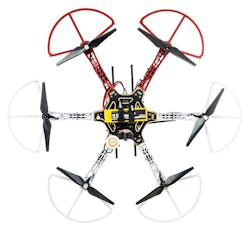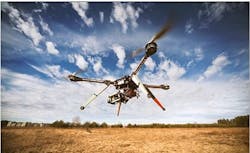FAA grants blanket approval to 1,120 drones… sort of
By Mark McKinnon and Mark Dombroff, partners, Dentons
In an unexpected move, the U.S. Federal Aviation Administration (FAA) has changed the terms of new Section 333 exemptions to permit the operation of any unmanned aircraft systems (UAS) that the agency has already approved. The current list of approved vehicles, which can be found at Regulations.gov under docket number FAA-2007-3330, includes more than 1,100 makes and models of aircraft. In addition, the FAA will update the list on a monthly basis to continue to add new vehicles that are eligible for use.
Exemptions granted in the last week now state:
The petitioner proposed to use UAS that have previously been approved by the Secretary of Transportation under Section 333 of the FAA Modernization and Reform Act of 2012. UAS that have been previously approved by the Secretary, including the aircraft proposed by the petitioner, are found on the List of Approved Unmanned Aerial Systems (UAS) under Section 333. The list, which is updated monthly, is posted at www.regulations.gov under docket number FAA-2007-3330. The petitioner is also authorized to operate any UAS on that list, when weighing less than 55 pounds including payload while this exemption is valid.
Prior to this change, anyone seeking permission to operate a UAS had to list specific makes and models of aircraft, and received an exemption limited to those aircraft. If an operator wanted to add a new type of aircraft, an amendment was required. Under this new language, an amendment will only be required if the operator wants to add a unique design that has not been previously been approved.
Unfortunately, due to the nature of exemptions, this change is not retroactive. The FAA is expected to add language to its website soon confirming that any operators with exemptions using the old language cannot operate on the basis of the list. The operator will need to file for an amendment and ask for permission to operate aircraft on the approved UAS list.
If, on the other hand, you are an operator and you currently have a petition pending to amend your exemption to add vehicles, then no further action should be necessary, as the new language will be applied by default.
For more information:
Visit Dentons’ website and Planely Spoken blog for more information on aerospace- and aviation-related legal issues.
Dentons' global team builds agile, tailored solutions to meet the local, national and global needs of private and public clients of any size in more than 125 locations serving 50-plus countries.
The complex aerospace industry ranges from aviation and aerospace service companies to airlines, charter companies, private operators, manufacturers, aircraft leasing companies and other financial institutions, airports, and governmental agencies. It’s an industry where you want specialists with aviation expertise, access to an experienced multijurisdictional team, and experts on the ground in the places you do business. Dentons’ lawyers know the aviation industry and combine global expertise with local knowledge in many areas.
You might also like:
Subscribe today to receive all the latest aerospace technology and engineering news, delivered directly to your e-mail inbox twice a week (Tuesdays and Thursdays). Sign upfor your free subscription to the Intelligent Inbox e-newsletter at http://www.intelligent-aerospace.com/subscribe.html.
Connect with Intelligent Aerospace on social media: Twitter (@IntelligentAero), LinkedIn,Google+, and Instagram.
Intelligent Aerospace
Global Aerospace Technology NetworkIntelligent Aerospace, the global aerospace technology network, reports on the latest tools, technologies, and trends of vital importance to aerospace professionals involved in air traffic control, airport operations, satellites and space, and commercial and military avionics on fixed-wing, rotor-wing, and unmanned aircraft throughout the world.



